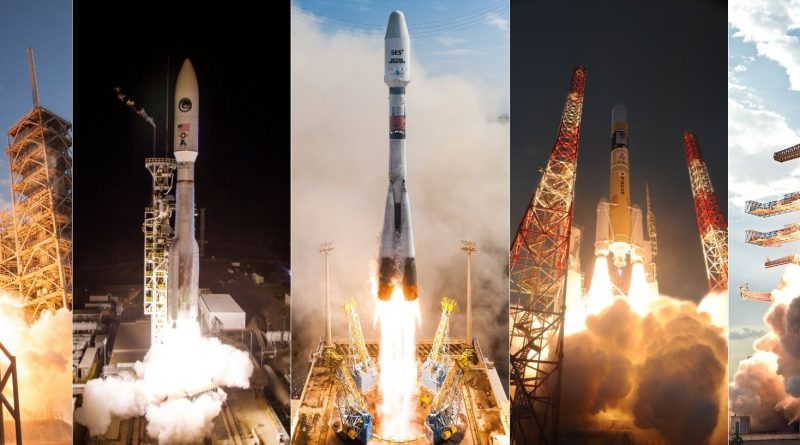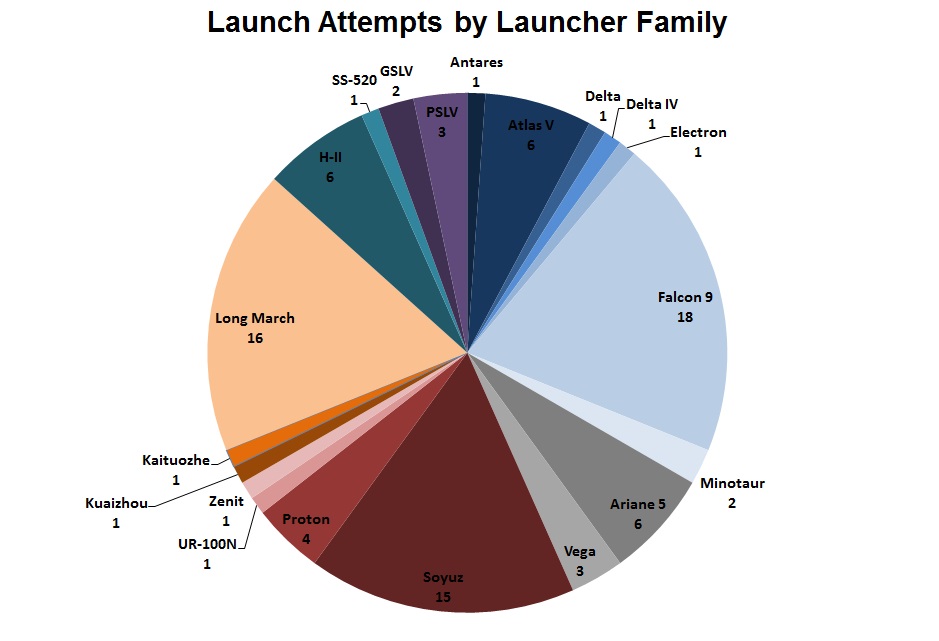2017 Space Launch Statistics
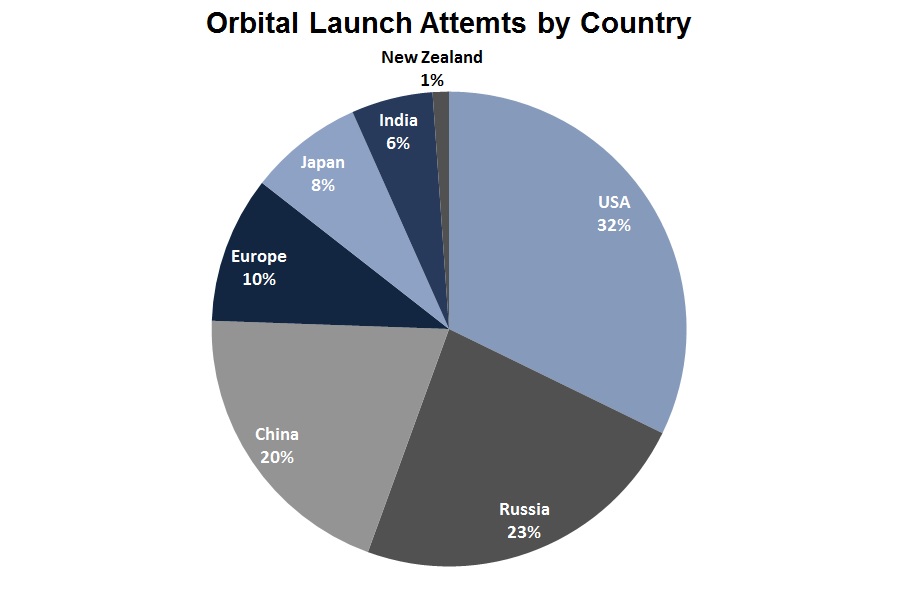 The year 2017 saw a total of 90 known orbital launch attempts from seven nations and space ports in eight different countries. 2017 had the second most orbital launch attempts of any year in the current century, short of 92 launches in 2014 and showing a slight increase from 2016 that had 85 known launch attempts.
The year 2017 saw a total of 90 known orbital launch attempts from seven nations and space ports in eight different countries. 2017 had the second most orbital launch attempts of any year in the current century, short of 92 launches in 2014 and showing a slight increase from 2016 that had 85 known launch attempts.
In the lead for 2017 are the United States with 29 (+1) orbital launch attempts, taking the top position on their own for the first time since 2003 after sharing it with China in 2016. Russia, having been the leader for most years since the turn of the century, ranks second in 2017 with 21 performed launches and the Chinese take third position with 18 missions. Europe's rockets flew nine times this year while Japan pushed its record for space launches conducted in a single year to seven and India took a slight step back with five launches in 2017.
Standing out in 2017 is SpaceX's Falcon 9 rocket - flying more times than any other launch system and beating out the Russian Soyuz that held this position for most of recent memory. In addition to managing a break-out year for the number of missions performed, SpaceX elevated aerospace technology to new heights by consistently recovering the company's Falcon 9 first stages and successfully launching five cores that had flown previously, taking operational re-use one major step closer to reality.
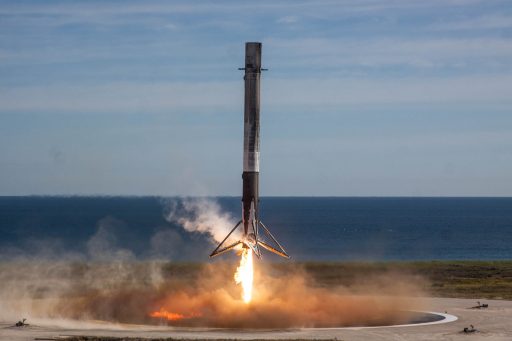
2017 saw a diversification of the global launcher fleet as China added two new vehicles, Japan tested out the world's smallest orbital launch vehicle and commercial launch provider Rocket Lab debuted its Electron rocket. More than 20 different launch vehicle families were in action in 2017, flying in 37 different vehicle configurations. One vehicle was officially retired as Russia's Soyuz U sailed into orbit one last time after a four-decade career.
The overall failure rate across the globe is slightly over average for modern-day spaceflight at 6.7% with five outright launch failures, one partial failure and one potential in-flight anomaly. Only the U.S. and Europe had a failure-free year; Russia's Soyuz/Fregat launch vehicle suffered one failure and one mysterious anomaly that left a subset of its payloads dead on arrival. China's new Long March 5 had a high-profile failure on its second test flight while the well-proven Long March 3B experienced a partial failure. A 20-year failure-free streak ended for India's PSLV while new launch vehicles failed for Japan and Rocket Lab.
| Country | Launches | Failures |
|---|---|---|
| USA | 29 | 0 |
| Russia | 21 | 1 |
| China | 18 | 2 |
| Europe | 9 | 0 |
| Japan | 7 | 1 |
| India | 5 | 1 |
| New Zealand | 1* | 1 |
| Total | 90 | 6 |
Failures & Incidents
| Date | Vehicle | Payload | Time of Incident | Cause |
|---|---|---|---|---|
| Jan 14 | SS-520-4 | TRICOM-1R | T+20.4 Seconds | Mechanical friction between an electrical wire and cable cut-out on the Stage2/3 interface caused abrasion of the cable insulation, leading to a short circuit between the cable & grounded vehicle structure. The resulting loss of signal from the experimental launch vehicle led to the flight being aborted after first stage burnout. |
| May 25 | Electron | It's A Test | T+4 Minutes | Ground Telemetry Receiver Misconfiguration: Forward Error Correction disabled by third-party contractor, causing data corruption as the vehicle traveled downrange & signal noise increased, leading to flight termination per range safety rules. |
| Jun 18 | Long March 3B | Zhongxing-9A | Approx. T+21 min | Third Stage Roll Control Problem: Vehicle was placed in a positive roll before its second burn where a negative roll is required, causing a partial loss of attitude control. Satellite injected into sub-GTO orbit, but maneuvered into GEO at the cost of around ten years of operational lifetime. |
| Jul 02 | Long March 5 | Shijian-18 | T+347 Seconds | Engine Failure: One of two YF-77 LOX/LH2 engines on the CZ-5 Core Stage suffered a turbopump-related failure, causing major performance loss leading to re-entry during second stage operation. Unconfirmed source reports point to a structural failure of the turbopump rotor shaft enclosure cap. |
| Jul 14 | Soyuz 2-1A / Fregat-M | 73 Satellites | Payload Separation | At least 9 satellites dead on arrival or severely degraded after separation from LV, reports of suspected anomaly creating conditions leading to failure of satellite electronics within specific payload bay. Mix-up between one of 48 Planet Lab's Doves and one of eight Spire Global Lemurs. |
| Aug 31 | PSLV-XL | IRNSS-1H | T+203 Seconds | Payload Fairing Separation Failure: Faulty separation bellows did not allow gas pressure to build up as needed to shear the rivets joining the two fairing halves. |
| Nov 28 | Soyuz 2-1B / Fregat-M | Meteor-M 2-1 + 18 Secondary Payloads | T+563 Seconds | Previously Undetected GNC Software Bug: Placement of Vostochny 1S launch pad caused a large roll requirement between Soyuz reference plane & launch azimuth, Fregat GNC platform failed to recognize 360° position as equal to 0° and initiated a 360-deg roll, causing gyro saturation & loss of attitude control during initial upper stage burn. |
| Dec 27 | Zenit-3SLBF | AngoSat 1 | Post-Separation | Potential Short-Circuit on Satellite, Loss of Contact shortly after separation from LV but recovered after one day |
Orbital Launch Activity 2017 - Summary
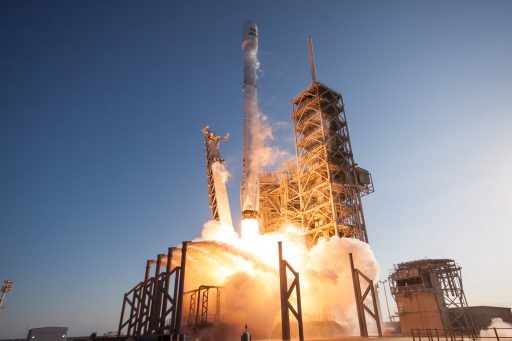
Taking the lead on its own for the first time since 2003, the United States conducted 29 orbital space launches from its own territory using six different launch vehicle families from three operators.
2017 was a record-shattering year for SpaceX, successfully completing 18 Falcon 9 missions and surpassing the company's previous best of eight launches in a calendar year. SpaceX's 2017 portfolio ranged from orbital logistics via the company's Dragon spacecraft, high-energy Geotransfer missions for telecommunications operators, classified and semi-classified launches for the U.S. government, missions in support of the largest satellite constellation upgrade performed to date, and an international flight in support of Earth's observation.
Responsible for 20% of all launches in 2017, SpaceX achieved its major goal of having a failure-free year to allow the company to demonstrate it can fly missions at a speedy pace with a rapid-fire campaign in the first half of the year that saw the company get six missions off the ground in nine weeks.
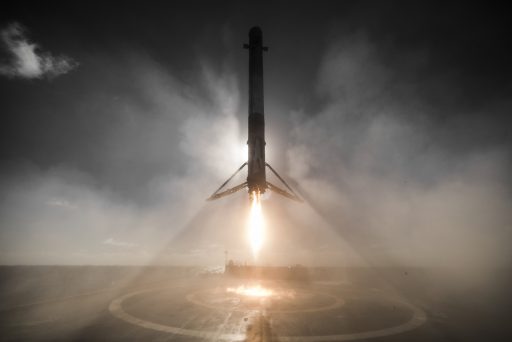
The California-based launch provider also made strides in the re-use department - completing 14 successful first stage recoveries at 100% success rate and flying five missions with 'flight-proven' - or previously used - boosters to take its re-use ambitions one major step closer to becoming routine. SpaceX also made progress in its fairing recovery endeavors with expectations of achieving intact fairing returns on a regular basis in 2018.
The company's 2017 manifest was dominated by Low Earth Orbit missions as Falcon 9 rockets flew four times with Dragon cargo vehicles and performed four flights in support of the Iridium-NEXT communications constellation upgrade, delivering a total of 40 satellites to orbit. Falcon's LEO business in 2017 also included two classified missions, lifting the mysterious NROL-76 satellite in May and the fifth mission of the X-37B winged spaceplane in September. SpaceX flew two Geotransfer missions for satellite operator SES, both using flight-proven vehicles, and one mission each for EchoStar, Inmarsat, BulgariaSat, Intelsat and KoreaSat.
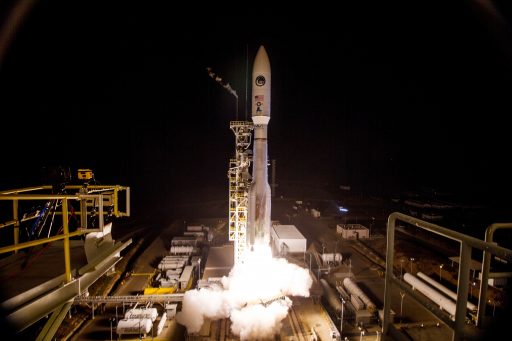
United Launch Alliance as the other large U.S. launch provider and primary SpaceX competitor, had a slower year - performing eight orbital launches in 2017: three for the United States National Reconnaissance Office, two for the U.S. Air Force, two for NASA and one for Orbital ATK.
Atlas V flew successfully six times in 2017, lifting the classified NROL-79, NROL-42 and NROL-52, the third SBIRS missile early warning satellite, NASA's TDRS-M Tracking and Data Relay Satellite and Orbital ATK's SS John Glenn, the company's seventh operational Cygnus spacecraft heading to the International Space Station. Delta IV flew only once, carrying the Wideband Global Satcom 9 satellite and Delta II completed its penultimate mission when lifting the JPSS-1 weather satellite for NASA and NOAA.
Flying six time in its 401 configuration and once in the larger 421 and 541 versions with boosters, Atlas V kept up its impeccable safety record while the single-stick Delta IV is slowly working toward retirement, with three more missions in 2018 and Delta II looking at the same fate with one final flight set for September 2018.
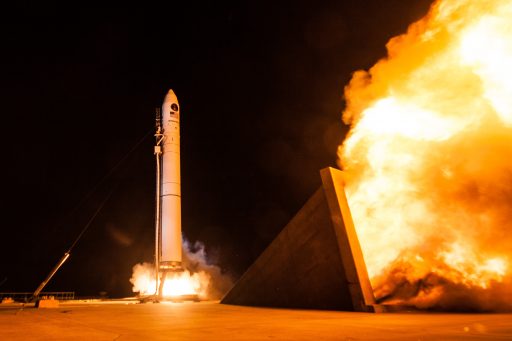
Orbital ATK conducted three launches in 2017 from three different U.S. space ports. The company kicked 2017 off with an Atlas V launch of the Cygnus OA-7 spacecraft as the third and final Cygnus launch planned to be outsourced to ULA in an effort to keep the company's obligations to the ISS program while working through the process of getting the re-engined Antares rocket into regular operations.
In August, a custom version of the company's Minotaur IV rocket - sporting an additional Orion 38 as fifth stage lifted off from SLC-46 at Cape Canaveral with the SensorSat space situational awareness spacecraft of the U.S. Air Force and three government-operated CubeSats - targeting a unique equatorial orbit from where SensorSat stares straight up to gather tracking data on objects in Geostationary Orbit. Minotaur-C - a commercial spin-off without government-furnished parts - launched from Vandenberg Air Force Base in October to lift six SkySat high-resolution imaging satellites and four medium-resolution Dove CubeSats into orbit for Planet Labs.
Antares flew for the second time in its 200 series in November, lifting the Cygnus "SS Gene Cernan" into orbit for a resupply mission to the International Space Station.
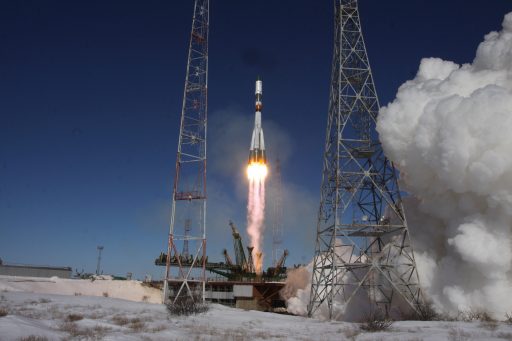
Russia operated 21 orbital launches in 2017, twenty of which managed to reach orbit as the country was not quite able to manage a perfect year which was last the case in 2003. The country's Soyuz workhorse launched 15 times in 2017, Proton had a slow year of re-building with four missions, Rockot flew once as it approaches its retirement and a rare Russian-Ukrainian collaboration was shown with a single Zenit launch toward the end of the year.
Soyuz, losing its status as the world's most-flown rocket in 2017, checked off four crewed flights to the International Space Station and continued to serve the Station's cargo needs via three Progress launches - two handled by the upgraded Soyuz 2-1A vehicle and one by the venerable Soyuz U. Blasting off from Baikonur in February, Soyuz U capped a record-setting career of 43 years and 786 launches - holding the record for the most-flown and longest serving launch system as well as the best mark for most missions carried out in a calendar year - flying 47 times in 1979.
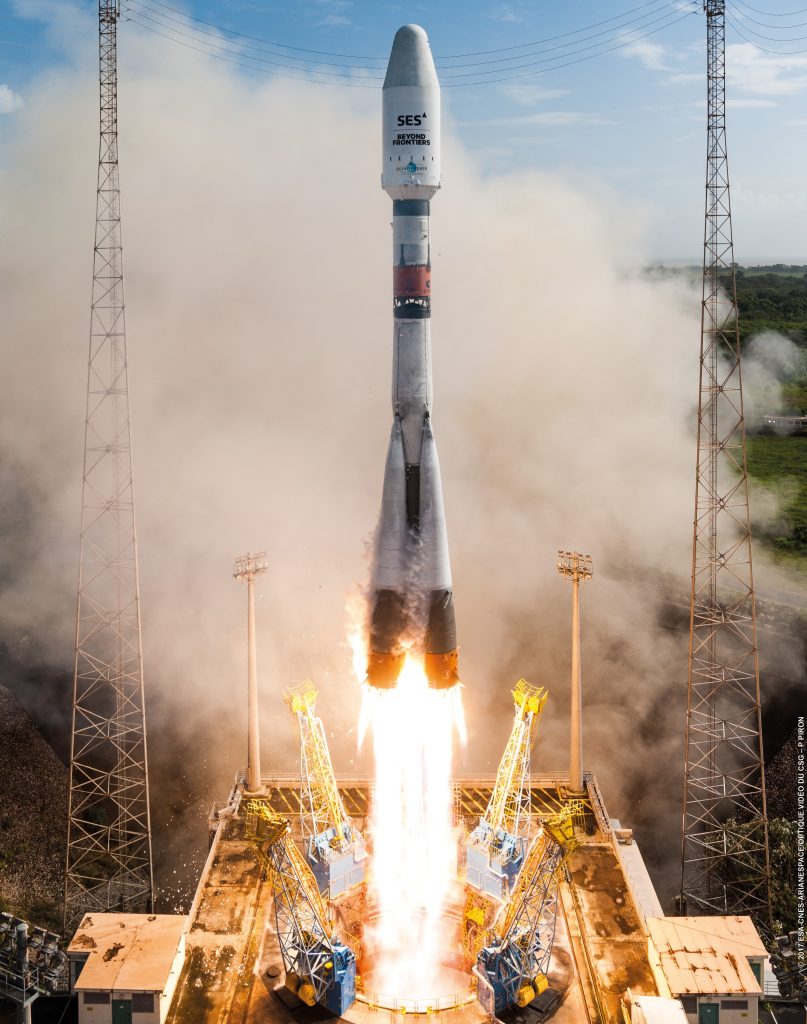
Russia's non-ISS Soyuz missions, all handled by the upgraded Soyuz 2 fleet, include five 2-1B, two 2-1A and one 2-1v - four from the Plesetsk Cosmodrome with a Tundra missile warning satellite, a Glonass navigation craft, Kosmos-2519 & company, and a Lotos signals intelligence satellite, one from the Baikonur Cosmodrome with 73 satellites and one from the new Vostochny Cosmodrome in Russia's far east.
Two Soyuz missions were performed by Arianespace from the Guiana Space Center, lifting the Hispasat 36W-1 and SES 15 communications satellites into Geostationary Transfer Orbit.
Russia's only failure of 2017 came on the Soyuz mission out of Vostochny that carried the Meteor-M 2-1 weather satellite and 18 international secondary payloads. The mission fell short of orbit because of a previously undetected software bug in the guidance system of the Fregat upper stage that can only manifest itself for polar-orbit launches out of Vostochny due to the launch pad's unique geographical orientation among all the Soyuz sites across the globe.
Another possible in-flight incident occurred on the 73-satellite mission out of Baikonur that left an unusually large number of satellites dead-on-arrival or severely degraded due to a suspected anomaly creating conditions for a subset of the payloads that even space-rated electronics could not withstand.
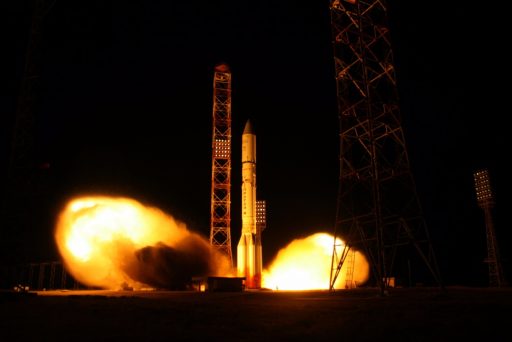
Proton - the major trouble-maker in recent years - had a slow year in 2017, coming back in June after break of one full year following a close call in 2016 that exposed a systemic engine problem affecting Proton and Soyuz and required Proton's powerplants to undergo fairly extensive refurbishment. The launcher's 2017 missions were comprised of a single flight in the interests of the Russian Ministry of Defence, deploying the Blagovest communications satellite, and three commercial flights handled by International Launch Services to deliver the EchoStar 21, Amazonas 5 and AsiaSat 9 communications satellites.
Rockot, approaching the conclusion of a career of nearly three decades, flew once in 2017 and lifted into orbit the Sentinel-5p mission for the European Commission's Copernicus program. The Russian-Ukrainian Zenit rocket - a victim of political conflicts between the two countries - flew once in 2017 in what is hoped to be the launcher's resurrection as cautious optimism emerged over the last year with tentative decisions on both sides to keep Zenit alive.
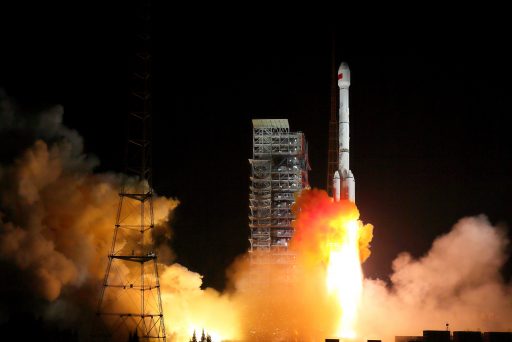
China had another busy year - performing sixteen launches with its Long March rocket fleet and adding two new vehicles that could become contenders on the commercial launch market via very low prices. Both Kuaizhou-1A and Kaituozhe-2 are all-solid launch vehicles capable of light-to-medium lift missions that may be of interest to LEO operators, particularly in the field of remote sensing.
China's heritage fleet, Long March-2, 3 and 4 handled 13 of the country's launches - supporting a range of missions in the civilian and military sectors. One of the focus points for China was the deployment of the initial Yagoan-30 constellation, requiring three Long March 2C launches to send nine satellites into three different orbital planes in what is suspected to be an electronic-intelligence collection system. Another apparent reconnaissance project, LKW, flying under the cover of a land surveying mission, launched two satellites in 2017.
The lone scientific mission orbited by the Chinese is the Hard X-Ray Modulation Telescope, studying the high-energy X-ray universe at unprecedented resolution.
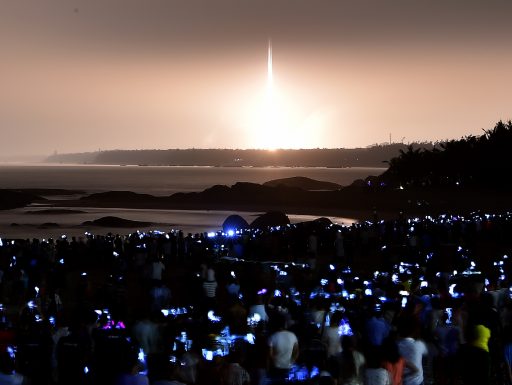
Long March 3B, China's well-proven heavy-lifter, experienced one partial failure - dropping the Zhongxing-9A communications satellite off in a lower-than-planned orbit due to an attitude control malfunction during its second burn, costing the satellite around ten years worth of operational life to make up for the shortfall. CZ-3B's other missions in 2017 went off without trouble, lifting three communications satellites to Geostationary Orbit and expanding China's Beidou navigation system via a two-satellite launch.
The country's new line of rockets, Long March 5, 6, 7 each flew once, marking the second flight for each of the new family members. The light-lifter, Long March 6, sent a trio of commercial imaging satellites into orbit while its bigger cousin, Long March 7, is partly responsible for China's biggest space success of 2017: the Tianzhou-1 cargo flight demonstration. Spending five months in orbit, TZ-1 completed three dockings with the Tiangong-2 laboratory module, demonstrated China's ability to complete in-orbit refueling and testing a fast rendezvous scheme as the last critical techniques needed for the operation of the country's large modular space station, starting deployment before the end of the decade.
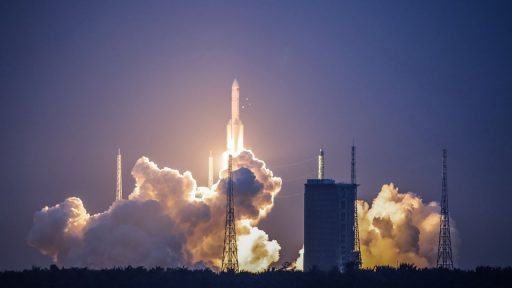
Long March 5, China's new heavy-lift vehicle, suffered a major setback when it failed to reach orbit on its second test flight that was hoped to clear the vehicle for high-profile missions like the Chang'e 5 lunar sample return and the TianHe space station core module. Lifting off from Hainan Island in July, Long March 5 lost one of its two YF-77 main engines a little over five minutes into the flight and the loss of performance could not be made up, causing the vehicle to re-enter the atmosphere during the second stage's attempts to save the mission.
The cause of the turbopump-related failure has been pin-pointed and corrective measures are being implemented on the YF-77 engine as China pushes toward another test flight around mid-year 2018 to get back on track toward deployment of the Chinese Space Station CSS and the eagerly awaited Chang'e two-way trip to the Moon.
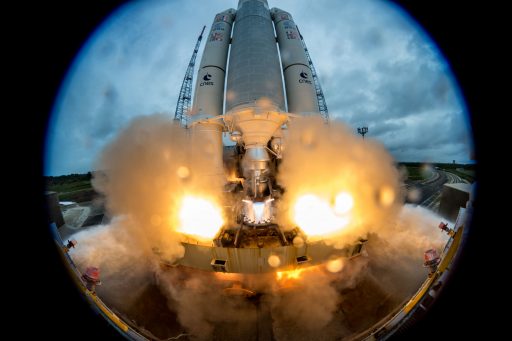
Europe's launch vehicles, the Ariane 5 workhorse and Vega light-lift vehicle, have continued to show a constant flight rate, equaling their 2016 record of nine missions, all successful. Ariane 5 flew six times in 2017, completing five missions in its ECA configuration and lifting pairs of heavy communications satellites into Geostationary Orbit which has become the bread and butter business for the European heavy-lifter. The remaining mission employed the ES version of Ariane 5 for the launcher's second flight backing the Galileo navigation satellite system, sending GalileoSat 19 through 22 into orbit to bring the constellation one step closer to fully operational capabilities.
Vega's 2017 missions were all in support of Earth observation, though with different objectives - sending the Sentinel-2B satellite into orbit for Copernicus, conducting a dual-launch of the technology demonstration and Earth-imaging VENµS and the OPTSAT-3000 reconnaissance satellite, and delivering the Mohammed VI-A satellite to give Morocco a space-based imaging platform for its national interests.
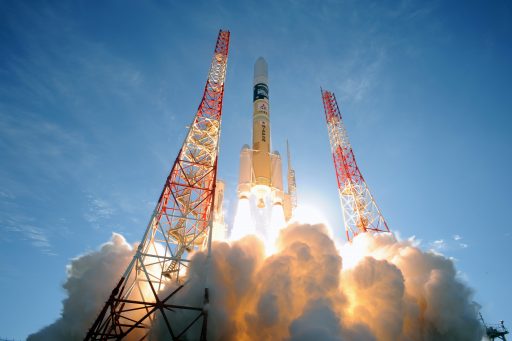
Japan's H-IIA rocket had a record-setting year, surpassing its previous benchmark of four missions by two flights. The rocket's 2017 manifest was dominated by the Quasi-Zenith Satellite System that received three new additions to establish the initial operational stage of four satellites in high orbits to enhance the availability of GPS navigation services in Japan's urban canyons and improve its accuracy for precise application in aviation and mapping. H-IIA also lifted the country's DSN-2 military communications satellite, a radar satellite for the Information Gathering Satellite System and the GCOM-C climate observatory.
To start the year, Japan attempted to launch the world's smallest orbital launch vehicle in a demonstration flight for potential future developments as a launch capability for single CubeSats has been deemed desirable by the commercial satellite market. However, the SS-520-4 sounding-rocket-turned-space-launcher failed after 20.4 seconds due to a relatively mundane design flaw. JAXA did commit to a re-flight mission and is on track to completing the flight around one year after the rocket's first attempt at reaching orbit.
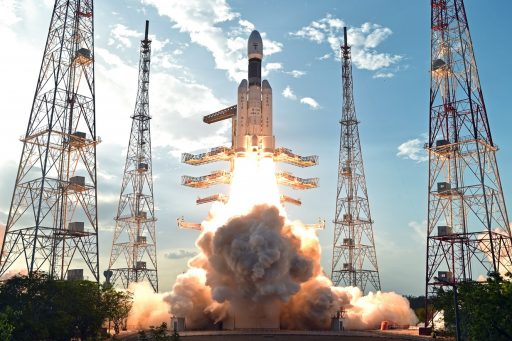
For India, success and failure were close neighbors in 2017. As the country came off a record-setting year in 2016 with seven missions, it hoped to keep up the pace and equal this record and also set new milestones in the business of small satellite rideshares.
India's Polar Satellite Launch Vehicle set a new record in February when creating literal bumper-to-bumper traffic in orbit - deploying a total of 104 satellites to set a new record for the most satellites launched by a single vehicle, a stark improvement over the previous record of 37 satellites delivered by a Dnepr rocket in 2014. On its second mission of the year, PSLV delivered the CartoSat-2E imaging satellite and 30 secondary payloads while the third flight lined up for 2017 was targeting a Geotransfer orbit with the IRNSS-1H replacement satellite for India's Regional Navigation Satellite System. That mission marked the end of a 20-year success streak for the PSLV rocket, failing to separate its payload fairing due to a faulty rubber bellows - essentially trapping the satellite in the closed fairing.
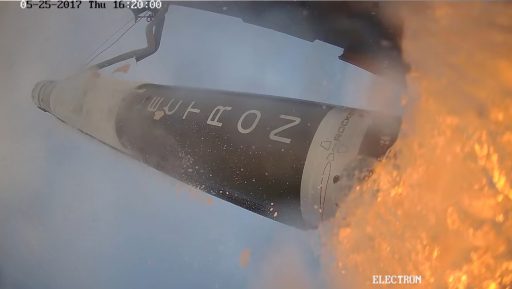
India's other rocket family, the Geosynchronous Satellite Launch Vehicle, flew twice in 2017 - the GSLV Mk.II launcher extended its success record when delivering the GSAT-9 South Asia communications satellite and the more powerful GSLV Mk.III checked off its first orbital test flight with GSAT-19 after an earlier sub-orbital demonstration flight.
Rounding out the world's 2017 launch manifest was Rocket Lab's Electron - blasting off from New Zealand in May on its first test flight. Although the mission fell short of orbit due to a misconfigured ground telemetry device, Electron managed to impress by demonstrating all critical flight events including stage separation and fairing jettisoning as well as the operation of its electric-pump-fed Rutherford engines. Electron is a special case for space statisticians: although built and operated by a New Zealand-based subsidiary, the parent company resides in the United States and Electron flies under U.S. flag & FAA regulation. Some may therefore count Electron to the U.S. total while others attribute Electron missions to New Zealand.
2017 Orbital Launch List
| Date | Time (UTC) | Launch Vehicle | Payloads | Launch Site | |
|---|---|---|---|---|---|
| Jan 05 | 15:18:04.043 | Long March 3B/G2 (Y39) | Tongxin Jishu Shiyan 2 (TJS-2) | LC-2, Xichang | S |
| Jan 09 | 04:11:12.026 | Kuaizhou 1A | Jilin 1-03, Xingyun Shiyan-1, Kaidun-1 | SLS-E1, Jiuquan | S |
| Jan 14 | 17:54:39 | Falcon 9 FT (B1029) | Iridium-NEXT Flight 1 (SV 102, 103, 104, 105, 106, 108, 109, 111, 112, 114) | SLC-4E, Vandenberg | S |
| Jan 14 | 23:33:00 | SS-520-4 | TRICOM-1 | Uchinoura | F |
| Jan 21 | 00:42 | Atlas V 401 (AV-066) | SBIRS GEO-3 (SV-4) | SLC-41, Cape Canaveral | S |
| Jan 24 | 07:44:00 | H-IIA 204 (F32) | DSN 2 (Kirameki-2) | Pad 1, Tanegashima | S |
| Jan 28 | 01:03:34.428 | Soyuz ST-B (VS16) | Hispasat 36W-1 | ELS, Guiana Space Center | S |
| Feb 14 | 21:39:07 | Ariane 5 ECA (VA235) | Telkom-3S, SkyBrasil-1 | ELA-3, Guiana Space Center | S |
| Feb 15 | 03:58 | PSLV-XL (C37) | Cartosat-2D, INS 1A & 1B, Flock-3p (88 Satellites), Lemur-2 22-29, BGUSat, DIDO 2, PEASS, Al-Farabi-1, Nayif 1 | FLP, Satish Dhawan | S |
| Feb 19 | 14:38:59.5 | Falcon 9 FT (B1031) | Dragon CRS-10 (Dragon C112) | LC-39A, Kennedy Space Center | S |
| Feb 22 | 05:58:33.318 | Soyuz U | Progress MS-05 (No. 435) | 1/5, Baikonur | S |
| Mar 01 | 17:49:51 | Atlas V 401 (AV-068) | USA 274 (Intruder 15 & 16) | SLC-3E, Vandenberg | S |
| Mar 02 | 23:53 | Kaituozhe 2 | Tiankun-1 | Jiuquan | S |
| Mar 07 | 01:49:24 | Vega (VV09) | Sentinel-2B | ZLV, Guiana Space Center | S |
| Mar 16 | 06:00 | Falcon 9 FT (B1030) | EchoStar 23 | LC-39A, Kennedy Space Center | S |
| Mar 17 | 01:20:00 | H-IIA 202 (F33) | IGS Radar-5 | Pad 1, Tanegashima | S |
| Mar 19 | 00:18:00 | Delta IV M+(5,4) | WGS 9 | SLC-37B, Cape Canaveral | S |
| Mar 30 | 22:27 | Falcon 9 FT (B1021.2) | SES-10 | LC-39A, Kennedy Space Center | S |
| Apr 12 | 11:04:04.133 | Long March 3B/G2 (Y43) | Shijian-13 / Zhongxing-16 | LC-2, Xichang | S |
| Apr 18 | 15:11:26 | Atlas V 401 (AV-070) | Cygnus OA-7 'SS John Glenn' (with QB50 Launch 1, ALTAIR, IceCube, CSUNSat 1, CXBN 2, KySat 3, Biarri-Point, Lemur-2 30-33) | SLC-41, Cape Canaveral | S |
| Apr 20 | 07:13:43.171 | Soyuz FG | Soyuz MS-04 (No. 735) | 1/5, Baikonur | S |
| Apr 20 | 11:41:35.361 | Long March 7 (Y2) | Tianzhou-1 (with Silk Road-1) | LC-201, Wenchang | S |
| May 01 | 11:15 | Falcon 9 FT (B1032) | USA 276 (NROL-76) | LC-39A, Kennedy Space Center | S |
| May 04 | 21:50:07 | Ariane 5 ECA (VA236) | KoreaSat 7, SGDC | ELA-3, Guiana Space Center | S |
| May 05 | 11:27 | GSLV Mk.II (F9) | GSAT-9 | SLP, Satish Dhawan | S |
| May 15 | 23:20:46 | Falcon 9 FT (B1034) | Inmarsat-5 F4 | LC-39A, Kennedy Space Center | S |
| May 18 | 11:54:53.193 | Soyuz ST-A (VS17) | SES-15 | ELS, Guiana Space Center | S |
| May 25 | 04:20:00 | Electron | It's A Test | Mahia LC-1 | F |
| May 25 | 06:33:41 | Soyuz 2-1B | EKS No. 2 (Kosmos-2518) | 43/4, Plesetsk | S |
| Jun 01 | 00:17:46 | H-IIA 202 (F34) | QZS-2 (Michibiki-2) | Pad 1, Tanegashima | S |
| Jun 01 | 23:45:07 | Ariane 5 ECA (VA237) | ViaSat-2, Eutelsat 172B | ELA-3, Guiana Space Center | S |
| Jun 03 | 21:07:38 | Falcon 9 FT (B1035) | Dragon CRS-11 (Dragon C106.2) (with BIRDS-B, G, J, M, N) | LC-39A, Kennedy Space Center | S |
| Jun 05 | 11:58 | GSLV Mk.III (D1) | GSAT-19E | SLP, Satish Dhawan | S |
| Jun 08 | 03:45:47.008 | Proton-M/Briz-M | EchoStar 21 | 81/24, Baikonur | S |
| Jun 14 | 09:20:13.013 | Soyuz 2-1A | Progress MS-06 (No. 436) (with Tanyusha YuZGU No. 1 & 2, TS530-Zerkalo, TNS 0-2) | 31/6, Baikonur | S |
| Jun 15 | 03:00 | Long March 4B (Y31) | HXMT (Huiyan), Zhuhai 1-01 & 1-02, NuSat 3 | SLS-2, Jiuquan | S |
| Jun 18 | 16:11 | Long March 3B | Zhongxing-9A | LC-2, Xichang | P |
| Jun 23 | 03:59 | PSLV-XL (C38) | Cartosat-2E, QB50 Launch 2, NIUSAT, CE-Sat 1, Max Valier, Venta 1, CICERO 6, 3 Diamonds, Lemur-2 34-41, D-Sat, Tyvak 53b, Aalto-1, Robusta-1B, SUCHAI, skCUBE | FLP, Satish Dhawan | S |
| Jun 23 | 18:04:33 | Soyuz 2-1v | Kosmos-2519 (Napryazhenie ?), Kosmos-2521 (Inspector Satellite), Kosmos-2523 ? (Subsatellite) | 43/4, Plesetsk | S |
| Jun 23 | 19:10:00 | Falcon 9 FT (B1029.2) | BulgariaSat 1 | LC-39A, Kennedy Space Center | S |
| Jun 25 | 20:25:14 | Falcon 9 FT (B1036) | Iridium-NEXT Flight 2 (SV 113, 115, 117, 118, 120, 121, 123, 124, 126, 128) | SLC-4E, Vandenberg | S |
| Jun 28 | 21:15 | Ariane 5 ECA (VA238) | Hellas Sat 3, GSAT-17 | ELA-3, Guiana Space Center | S |
| Jul 02 | 11:23:23.425 | Long March 5 (Y2) | Shijian-18 | LC-101, Wenchang | F |
| Jul 05 | 23:38:00 | Falcon 9 FT (B1037) | Intelsat 35e | LC-39A, Kennedy Space Center | S |
| Jul 14 | 06:36:49 | Soyuz 2-1A | Kanopus V-IK No. 2, Flying Laptop, CICERO-1, 2, 3, Corvus-BC 1 & 2, WNISAT-1R, TechnoSat, NORSAT-1 & 2, Mayak, NanoACE, MKA-N 1 & 2, Lemur-2 42-49, Flock-2k (48 Satellites) | 31/6, Baikonur | S |
| Jul 27 | ~09:30 | Simorgh | ? | Semnan | ** |
| Jul 28 | 15:41:12.285 | Soyuz FG | Soyuz MS-05 (No. 736) | 1/5, Baikonur | S |
| Aug 02 | 01:58:33 | Vega (VV10) | Optsat 3000, Venµs | ZLV, Guiana Space Center | S |
| Aug 14 | 16:31:37 | Falcon 9 FT (B1039) | Dragon CRS-12 (Dragon C113) (with KestrelEye II-M, ASTERIA, Dellingr, OSIRIS-3U) | LC-39A, Kennedy Space Center | S |
| Aug 16 | 22:06:59.975 | Proton-M/Briz-M | Blagovest No. 11L (Kosmos-2520) | 81/24, Baikonur | S |
| Aug 18 | 12:29 | Atlas V 401 (AV-074) | TDRS-M (TDRS 13) | SLC-41, Cape Canaveral | S |
| Aug 19 | 05:29:00 | H-IIA 204 (F35) | QZS-3 (Michibiki-3) | Pad 1, Tanegashima | S |
| Aug 24 | 18:51 | Falcon 9 FT (B1038) | FormoSat-5 | SLC-4E, Vandenberg | S |
| Aug 26 | 06:04:00.224 | Minotaur IV (Orion 38) | ORS-5: SensorSat, DFHR, Prometheus 2.2 & 2.4 | SLC-46, Cape Canaveral | S |
| Aug 31 | 13:30 | PSLV-XL (C39) | IRNSS-1H | SLP, Satish Dhawan | F |
| Sep 07 | 14:00 | Falcon 9 FT (B1040) | X-37B OTV-5 | LC-39A, Kennedy Space Center | S |
| Sep 11 | 19:23:40.953 | Proton-M/Briz-M | Amazonas 5 | 200/39, Baikonur | S |
| Sep 12 | 21:17:02.407 | Soyuz FG | Soyuz MS-06 (No. 734) | 1/5, Baikonur | S |
| Sep 22 | 00:02:32 | Soyuz 2-1B | Glonass-M No. 52 (Kosmos-2522) | 43/4, Plesetsk | S |
| Sep 24 | 05:49:47 | Atlas V 541 (AV-072) | USA 278 (NROL-42, Trumpet FO 2-2) | SLC-3E, Vandenberg | S |
| Sep 28 | 18:52:16.007 | Proton-M/Briz-M | AsiaSat 9 | 200/39, Baikonur | S |
| Sep 29 | 04:21:05.318 | Long March 2C (Y29) | Yaogan-30 Group 01 (3 Satellites) | LC-3, Xichang | S |
| Sep 29 | 21:56:07 | Ariane 5 ECA (VA239) | Intelsat 37e, BSAT-4a | ELA-3, Guiana Space Center | S |
| Oct 09 | 04:13:14.451 | Long March 2D (Y30) | VRSS-2 Antonio Jose de Sucre | Pad 603, Jiuquan | S |
| Oct 09 | 12:37:01 | Falcon 9 FT (B1041) | Iridium-NEXT Flight 3 (SV 107, 119, 122, 125, 127, 129, 132, 133, 136, 139) | SLC-3E, Vandenberg | S |
| Oct 09 | 22:01:37 | H-IIA 202 (F36) | QZS-4 (Michibiki-4) | Pad 1, Tanegashima | S |
| Oct 11 | 22:53 | Falcon 9 FT (B1031.2) | SES-11 | LC-39A, Kennedy Space Center | S |
| Oct 13 | 09:27:44.025 | Rockot | Sentinel-5p | 133/3, Plesetsk | S |
| Oct 14 | 08:46:53.478 | Soyuz 2-1A | Progress MS-07 (No. 437) | 31/6, Baikonur | S |
| Oct 15 | 07:28 | Atlas V 421 (AV-075) | USA 279 (NROL-52, Quasar) | SLC-41, Cape Canaveral | S |
| Oct 30 | 19:34 | Falcon 9 FT (B1042) | KoreaSat 5A | LC-39A, Kennedy Space Center | S |
| Oct 31 | 21:37 | Minotaur-C 3210 | SykSat C6-C11, Flock-3m (4 Satellites) | SLC-576E, Vandenberg | S |
| Nov 05 | 11:45:04.244 | Long March 3B (Y46) | Beidou DW 24 & 25 | LC-3, Xichang | S |
| Nov 08 | 01:42:31 | Vega (VV11) | Mohammed VI-A | ZLV, Guiana Space Center | S |
| Nov 12 | 12:19:54.6 | Antares 230 | Cygnus OA-8 'SS Gene Cernan' (with ECAMSat, TechEdSat 6, ISARA, CHEFsat, Asgardia, OCSD B & C, PropCube 2 (Fauna), Lemur-2 50-57) | Pad 0A, MARS, Wallops | S |
| Nov 14 | 18:35:54.570 | Long March 4C (Y21) | Fengyun-3D, HEAD-1 | LC-9, Taiyuan | S |
| Nov 18 | 09:47:36 | Delta II 7920-10C | JPSS-1 (NOAA-20), MiRaTA, Buccaneer-RMM, MakerSat-0, RadFxSat, EagleSat | SLC-2W, Vandenberg | S |
| Nov 21 | 04:50:13.723 | Long March 6 (Y2) | Jilin 1-04, 1-05 & 1-06 | LC-16, Taiyuan | S |
| Nov 24 | 18:10:05.130 | Long March 2C (Y33) | Yaogan-30 Group 02 (3 Satellites) | LC-3, Xichang | S |
| Nov 28 | 05:41:45.965 | Soyuz 2-1B | Meteor-M 2-1, Baumanets 2, LEO Vantage 2. IDEA OSG-1, Corvus-BC 3 & 4, AISSat-3, SEAM, D-Star One, Lemur-2 58-67 | 1S, Vostochny | F |
| Dec 02 | 10:43:26.331 | Soyuz 2-1B | Lotos-S1 No. 803 (Kosmos-2524) | 43/4, Plesetsk | S |
| Dec 03 | 04:11:14.524 | Long March 2D (Y47) | LKW-1 | Pad 603, Jiuquan | S |
| Dec 10 | 16:40:04.230 | Long March 3B (Y40) | Alcomsat 1 | LC-2, Xichang | S |
| Dec 12 | 18:36:07 | Ariane 5 ES (VA240) | Galileo FM-15, 16, 17, 18 (Galileosat 19, 20, 21, 22) | ELA-3, Guiana Space Center | S |
| Dec 15 | 15:36:09 | Falcon 9 FT (B1035.2) | Dragon CRS-13 (Dragon C107.2) | SLC-40, Cape Canaveral | S |
| Dec 17 | 07:21:01.127 | Soyuz FG | Soyuz MS-07 (No. 737) | 1/5, Baikonur | S |
| Dec 23 | 01:26:22 | H-IIA 202 (F37) | GCOM-C (Shikisai), SLATS (Tsubame) | Pad 1, Tanegashima | S |
| Dec 23 | 01:27:34 | Falcon 9 FT (B1036.2) | Iridium-NEXT Flight 4 (SV 116, 130, 131, 134, 135, 137, 138, 141, 151, 153) | SLC-4E, Vandenberg | S |
| Dec 23 | 04:14:26.237 | Long March 2D (Y48) | LKW-2 | Pad 603, Jiuquan | S |
| Dec 25 | 19:44:05.269 | Long March 2C (Y34) | Yaogan-30 Group 03 (3 Satellites) | LC-3, Xichang | S |
| Dec 26 | 19:00:03.435 | Zenit-3SLBF | AngoSat 1 | 45/1, Baikonur | S |
Space-Based Deployments
| Date | Time (UTC) | Host Vehicle | Payloads | |
|---|---|---|---|---|
| Jan 16 | 09:11 | ISS, JSSOD-6 | ITF-2, FREEDOM, WASEDA-Sat-3 | |
| Jan 16 | 09:23 | ISS, JSSOD-6 | EGG | |
| Jan 16 | 10:40 | ISS, JSSOD-6 | AOBA-VELOX | |
| Jan 16 | 10:50 | ISS, JSSOD-6 | TuPOD | |
| Jan 19 | TuPOD | Tancredo-1, OSNSAT | ||
| Mar 6 | 10:25 | ISS, NRCSD-10 | Lemur-2-Trutna, Lemur-2-TrutnaHD | |
| Mar 6 | 15:05 | ISS, NRCSD-10 | Lemur-2-Austintacious, Lemur-2-Redfern-Goes | |
| Mar 6 | 18:20 | ISS, NRCSD-10 | TechEdSat-5 | |
| May 16 | 08:25 | ISS, NRCSD-11 | SOMP-2 (QB50-DE02), Havelsat (QB50-TR02), Columbia Sat (QB50-US04) | |
| May 16 | 11:55 | ISS, NRCSD-11 | KySat-3/SGSAT, CXBN 2, IceCube | |
| May 17 | 01:45 | ISS, NRCSD-11 | Phoenix (QB50-TW01), X-CubeSat (QB50-FR01), qbee50-LTU-OC (QB50-SE01) | |
| May 17 | 08:13 | ISS, NRCSD-11 | ALTAIR | |
| May 17 | 12:40 | ISS, NRCSD-11 | SHARC | |
| May 18 | 01:00 | ISS, NRCSD-11 | ZA-Aerosat (QB50-AZ01), LINK (QB50-KR01) | |
| May 18 | 04:15 | ISS, NRCSD-11 | CSUNSat 1 | |
| May 18 | 08:25 | ISS, NRCSD-11 | UPSat (QB50-GR02), SpaceCube (QB50-FR05), Hoopoe (QB50-IL01) | |
| May 25 | 05:25 | ISS, NRCSD-12 | Challenger Sat (QB50-US01), NJUST-1 (QB50-CN03), USNQ-ECO (QB50-AU02) | |
| May 25 | 08:35 | ISS, NRCSD-12 | DUTHSat (QB50-GR01), Zidingxiang-1 (QB50-CN02), nSIGHT 1 (QB50-AZ02) | |
| May 25 | 11:55 | ISS, NRCSD-12 | QBITO (QB50-ES01), Aalto-2 (QB50-FI01), SUSat (QB50-AU01) | |
| May 25 | 23:40 | ISS, NRCSD-12 | SNUSAT 1b (QB50-KR03) | |
| May 26 | 04:00 | ISS, NRCSD-12 | i-INSPIRE 2 (QB50-AU03), PolyITAN-2-SAU (QB50-UA01), SNUSAT 1 (QB50-KR02) | |
| May 26 | 08:55 | ISS, NRCSD-12 | Ex-Alta 1 (QB50-CA03) | |
| May 26 | 12:15 | ISS, NRCSD-12 | Aoxiang 1 (QB50-CN04), BeEagleSat (QB50-TR01), Atlantis Sat (QB50-US02) | |
| Jun 08 | 17:53 | Cygnus OA-7 | Lemur-2-JennyBarna, Lemur-2-Angela | |
| Jun 08 | 21:03 | Cygnus OA-7 | Lemur-2-Spirovision, Lemur-2-RobMoore | |
| Jun 26 | 21:15 | ISS/ROSA | ROSA (Roll Out Solar Array) [Jettisoned for Disposal] | |
| Jul 07 | 08:55 | JSSOD-7 | BIRDS (TOKI, GhanaSat-1, Mazaalai) | |
| Jul 07 | 09:10 | JSSOD-7 | BIRDS (BRAC ONNESHA, Nigeria EduSat-1) | |
| Aug 01 | 07:03 | Tianzhou-1 | Silk Road 1 (Silu-1) | |
| Aug 17 | 15:10 | ISS, Russian EVA-43 | TOMSK-TPU-120 | |
| Aug 17 | 15:15 | ISS, Russian EVA-43 | Tanyusha YuZGU No.1 | |
| Aug 17 | 15:16 | ISS, Russian EVA-43 | Tanyusha YuZGU No.2 | |
| Aug 17 | 15:21 | ISS, Russian EVA-43 | TNS-02 No.2 | |
| Aug 17 | 15:29 | ISS, Russian EVA-43 | TS-530 Zerkalo | |
| Oct 24 | 09:45 | ISS, Kaber | Kestrel Eye II-M | |
| Oct 27 | 09:15 | ISS, Kaber | SIMPL | |
| Nov 20 | 08:05 | ISS, NRCSD-13 | ECAMSat | |
| Nov 20 | 12:25 | ISS, NRCSD-13 | ASTERIA | |
| Nov 20 | 17:02 | ISS, NRCSD-13 | Dellingr | |
| Nov 21 | 08:25 | ISS, NRCSD-13 | TechEdSat-6 | |
| Nov 21 | 11:40 | ISS, NRCSD-13 | OSIRIS-3U | |
| Dec 6 | 19:24 | Cygnus OA-8 | Lemur-2-YongLin, Lemur-2-Kevin, CHEFSat, Aerocube 7B & 7C (OCSD B & C) | |
| Dec 6 | 22:40 | Cygnus OA-8 | Lemur-2-BrianDavie, Lemur-2-RomaCoste, PropCube 2 (Fauna), Asgardia 1, ISARA | |
| Dec 7 | 02:00 | Cygnus OA-8 | Lemur-2-RocketJonah, Lemur-2-Liu-Poh-Chun, Lemur-2-McCullagh, Lemur-2-Dunlop |
Launches by Vehicle Configuration
| Launch Vehicle | Launches | Failures/Anomalies |
|---|---|---|
| Antares 230 | 1 | |
| Ariane 5 ECA | 5 | |
| Ariane 5 ES | 1 | |
| Atlas V 401 | 4 | |
| Atlas V 421 | 1 | |
| Atlas V 541 | 1 | |
| Delta II 7920-10C | 1 | |
| Delta IV M+(5,4) | 1 | |
| Electron | 1 | 1 Failure |
| Falcon 9 FT (New) | 13 | |
| Falcon 9 FT (Re-Use) | 5 | |
| GSLV Mk.II | 1 | |
| GSLV Mk.III | 1 | |
| H-IIA 202 | 4 | |
| H-IIA 204 | 2 | |
| Kuaizhou-1A | 1 | |
| Kaituozhe-2 | 1 | |
| Long March 2C | 3 | |
| Long March 2D | 3 | |
| Long March 3B | 5 | 1 Partial Failure |
| Long March 4B | 1 | |
| Long March 4C | 1 | |
| Long March 5 | 1 | 1 Failure |
| Long March 6 | 1 | |
| Long March 7 | 1 | |
| Minotaur IV | 1 | |
| Minotaur C | 1 | |
| Proton-M/Briz-M | 4 | |
| PSLV | 3 | 1 Failure |
| Rockot | 1 | |
| Soyuz 2-1A (incl ST-A) | 4 | |
| Soyuz 2-1B (incl ST-B) | 5 | 1 Failure |
| Soyuz 2-1v | 1 | |
| Soyuz FG | 4 | |
| Soyuz U | 1 | |
| SS-520 | 1 | 1 Failure |
| Vega | 3 | |
| Zenit | 1 | |
| Total | 90 | 6 |

